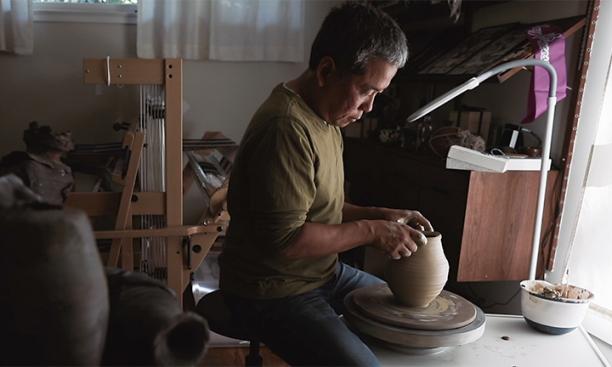
When he’s not running an applied physics lab at Stanford University or teaching classes, Hideo Mabuchi ’92 works out of his home studio producing unglazed, improvisational clay vessels.
When asked to describe the feeling of making these ceramics, the word Mabuchi offers up is an unusual one. Proprioception: the body’s awareness of moving through space. Mabuchi’s sculptural practice always begins with him feeling his way, proprioceptively, through what might be called “clayspace”: a tactile realm where Mabuchi can tune in to what the earth is trying to tell him in its language beyond language.
“A lot of what I like to do is just see what sorts of things my clay does on its own. And then find forms that express those qualities aesthetically, so that the nature of the clay is really visible in the final piece,” he says.
In 2000, Mabuchi won a MacArthur Foundation grant for lab work that draws on the field of optics to investigate quantum behavior; he’s been at Stanford since 2010.
But although Mabuchi is a physicist by trade and training, he also took comparative literature and philosophy courses while an undergrad at Princeton — an experience, he says, that helped him appreciate how to make connections between seemingly disparate disciplines.
In addition to his advanced physics classes, Mabuchi also teaches courses at Stanford that explore intersections among physics, literature, biology, history, and art. For a class on indigo, for example, Mabuchi had students grow their own indigo plants, process them into dye, and then study the science behind why plants create pigment, all of which Mabuchi didn’t know much about himself before conceiving of the course.
Mabuchi has described assembling these courses as a creative outlet that informs both his scientific and artistic practices. Since the indigo class, for example, Mabuchi has added a weaving loom to his ceramics studio and continues to draw inspiration from how crystallized indigo can function as a semiconductor.
In the lab, Mabuchi often finds himself building and maneuvering large machines for his optics experiments. But the atoms at the heart of his work remain untouchable; working with clay provides a good counterbalance, he says, because so much of the knowledge he’s gained is firsthand.
His interest developed soon after he first arrived in Palo Alto, when he began to collect Japanese ceramics with a particular focus on wood-fired, unglazed sake cups. Soon after, he tried his hand at making clay forms himself, tracking down American versions of those wood-fired kilns. When used to fire raw clay, these kilns create an environment in which ceramic surfaces bloom and crackle with color, without the need to apply any extra pigment. To Mabuchi, it’s a wondrous, somewhat mysterious transformation — even if he also once spent eight years using electron microscopy to study how a certain shade of red forms on unglazed clay.
Today, Mabuchi remains hooked on ceramics, sometimes joining other enthusiasts on wildcat scouting expeditions to find new veins of “wild clay” in the California countryside. After years of using a pottery wheel, he now mostly creates sculptures by hand, using a custom blend of Northern California fire clays mixed with a little bit of Custer, Montana, feldspar. He has begun to show his work in galleries, including at a group show of “wild clay” artists running through December at Denmark’s CLAY Museum of Ceramic Art.
“The most valuable thing of over time is not the things that you make,” Mabuchi reflects. “It’s this long term investment in developing an understanding and relationship with clay as a natural material.”
